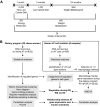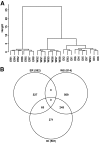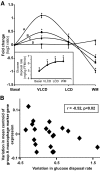Macrophages and adipocytes in human obesity: adipose tissue gene expression and insulin sensitivity during calorie restriction and weight stabilization
- PMID: 19401422
- PMCID: PMC2699855
- DOI: 10.2337/db09-0033
Macrophages and adipocytes in human obesity: adipose tissue gene expression and insulin sensitivity during calorie restriction and weight stabilization
Abstract
Objective: We investigated the regulation of adipose tissue gene expression during different phases of a dietary weight loss program and its relation with insulin sensitivity.
Research design and methods: Twenty-two obese women followed a dietary intervention program composed of an energy restriction phase with a 4-week very-low-calorie diet and a weight stabilization period composed of a 2-month low-calorie diet followed by 3-4 months of a weight maintenance diet. At each time point, a euglycemic-hyperinsulinemic clamp and subcutaneous adipose tissue biopsies were performed. Adipose tissue gene expression profiling was performed using a DNA microarray in a subgroup of eight women. RT-quantitative PCR was used for determination of mRNA levels of 31 adipose tissue macrophage markers (n = 22).
Results: Body weight, fat mass, and C-reactive protein level decreased and glucose disposal rate increased during the dietary intervention program. Transcriptome profiling revealed two main patterns of variations. The first involved 464 mostly adipocyte genes involved in metabolism that were downregulated during energy restriction, upregulated during weight stabilization, and unchanged during the dietary intervention. The second comprised 511 mainly macrophage genes involved in inflammatory pathways that were not changed or upregulated during energy restriction and downregulated during weight stabilization and dietary intervention. Accordingly, macrophage markers were upregulated during energy restriction and downregulated during weight stabilization and dietary intervention. The increase in glucose disposal rates in each dietary phase was associated with variation in expression of sets of 80-110 genes that differed among energy restriction, weight stabilization, and dietary intervention.
Conclusions: Adipose tissue macrophages and adipocytes show distinct patterns of gene regulation and association with insulin sensitivity during the various phases of a dietary weight loss program.
Figures





References
-
- Hotamisligil GS: Inflammation and metabolic disorders. Nature 2006; 444: 860– 867 - PubMed
Publication types
MeSH terms
Substances
LinkOut - more resources
Full Text Sources
Other Literature Sources
Medical
Molecular Biology Databases
Research Materials

